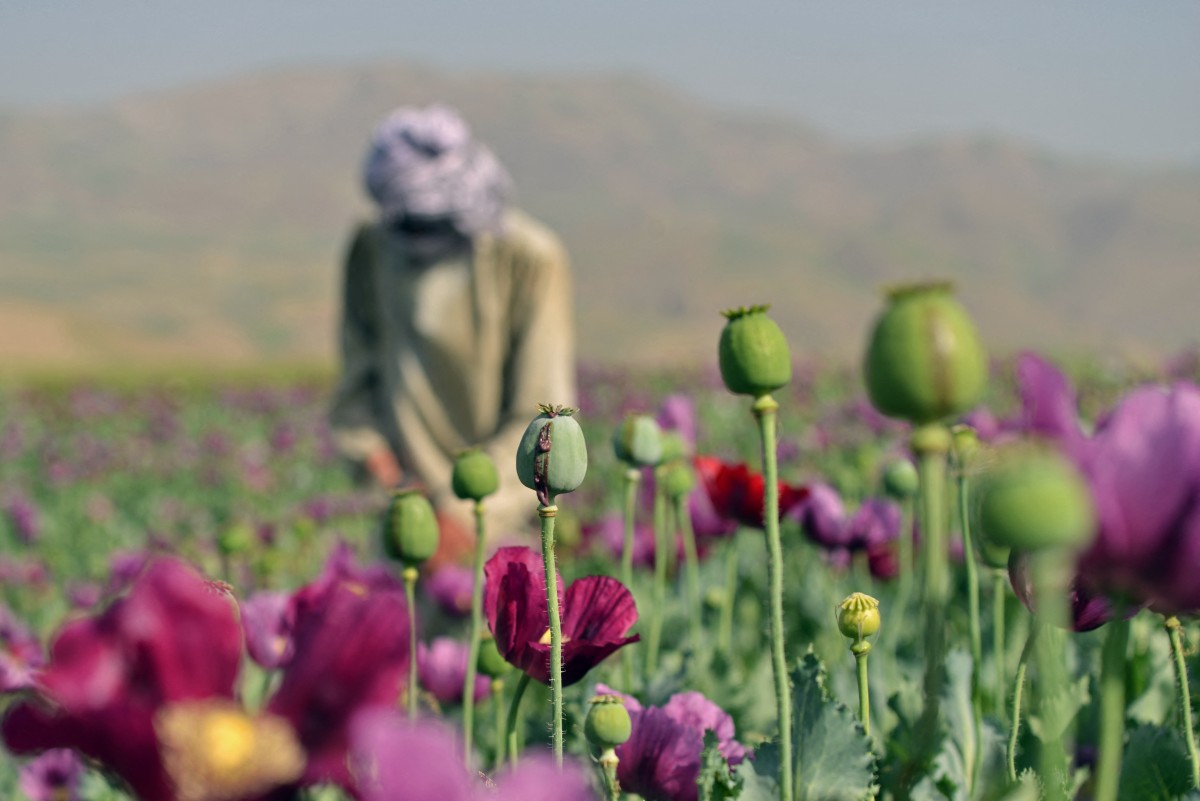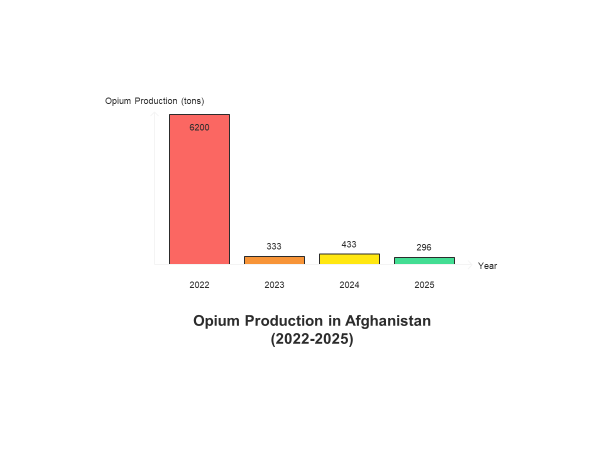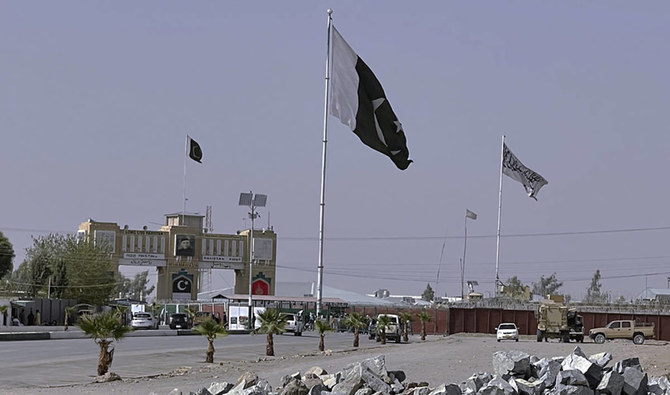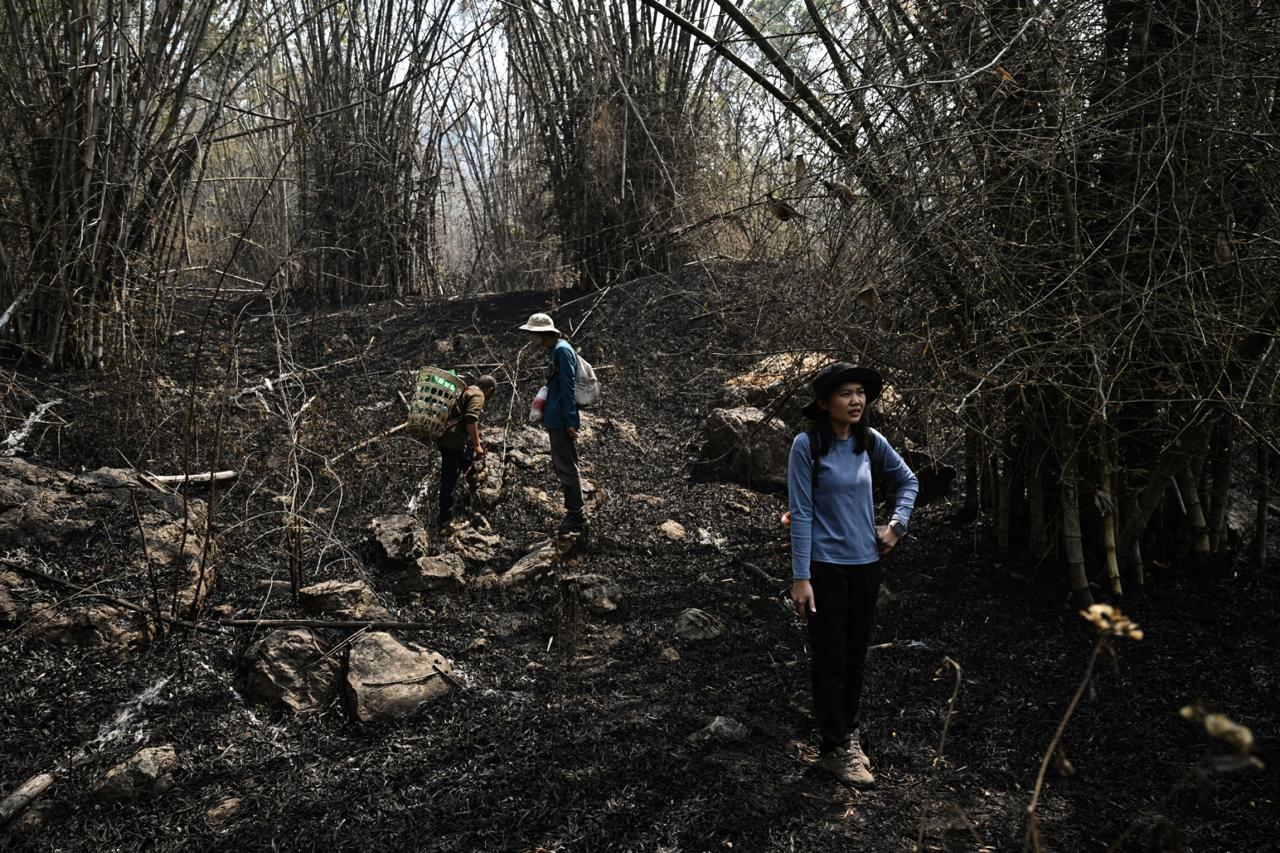
An Afghan farmer harvests opium from a poppy field on the outskirts of Faizabad district in Badakhshan province on May 12, 2025. (AFP)
ISLAMABAD: Afghanistan, which for decades supplied approximately 80% of the world's illicit opium, continues to cultivate opium poppies despite a dramatic 95% collapse in production since authorities enforced a nationwide ban three years ago, according to the latest United Nations report.
The Afghanistan Opium Survey 2025, published by the UN Office on Drugs and Crime, revealed potential opium production fell 32% in 2025 to just 296 tons, down from 433 tons in 2024.
Cultivation dropped 20% to 10,200 hectares, a fraction of the 232,000 hectares planted in 2022 before the Taliban regime implemented its prohibition decree.
 Source: UNODC Afghanistan Opium Survey 2025
Source: UNODC Afghanistan Opium Survey 2025
The report, however, warned Afghanistan's infrastructure, agricultural expertise and economic desperation could create conditions for potential resurgence. Opium prices remained five times higher than pre-ban averages.
Economic pressure threatens gains
The 296 tons of opium produced in 2025 could be converted into approximately 22-34 tons of export-quality heroin. That is substantially lower than the 350-580 tons Afghanistan was capable of producing in 2022. The country has retained the capacity that once made it the global epicenter of opium production.
Farmers' income from opium sales dropped 48% to $134 million in 2025. A hectare of opium still generated about $17,000 in Helmand province and $12,000 in Badakhshan.
By comparison, wheat yields only about $800 per hectare. Cotton provides roughly $1,600 per hectare.
Regional shift in production
The report documented a "balloon effect." Enforcement in Afghanistan appears to have displaced cultivation to neighboring countries. Eradication of opium poppy in two countries near Afghanistan increased from 5,868 hectares in 2022 to 13,200 hectares in 2023.
Within Afghanistan, cultivation is concentrated in the northeastern province of Badakhshan. The province accounted for 6,639 hectares, or 65% of the national total.
The southwestern region, historically the main production area, saw cultivation drop to just 1,294 hectares.
Geographic shift: Cultivation moves from southwest to northeast
Region | 2022 (hectares) | 2022 (%) | 2025 (hectares) | 2025 (%) |
South-Western | 169,791 | 73% | 1,294 | 13% |
North-eastern | 4,920 | 2% | 6,913 | 68% |
Northern | 16,415 | 7% | 566 | 6% |
Western | 33,059 | 14% | 756 | 7% |
Eastern | 7,165 | 3% | 252 | 2% |
Other | 1,650 | 1% | 419 | 4% |
Source: UNODC Afghanistan Opium Survey 2025, tables 1 and 2
Ban enforcement continues
The Taliban regime reported eradicating over 4,000 hectares of opium poppy in 2025. That represents approximately 40% of estimated cultivation.
Eradication efforts occasionally sparked violent resistance. Reports suggest around a dozen civilians were killed in Badakhshan districts.
Four provinces, Balkh, Farah, Laghman and Uruzgan, were declared opium poppy-free in 2025. Cultivation dropped below 100 hectares in those provinces.
Converging crises threaten stability
Severe drought conditions affected 64% of households in 2024. Rainfall was 75-90% below average in northern, central and northeastern regions. More than 40% of available farmland remained fallow. The lack of profitable alternatives and adverse climate conditions contributed to the fallow land.
The economic loss from reduced opiate production coincided with the return of approximately 4 million Afghans from neighboring Pakistan and Iran since September 2023. The returns intensified competition for scarce jobs and resources.
Methamphetamine emerges as new threat
While opiate production declined sharply, the report documented a concerning rise in methamphetamine trafficking. By the end of 2024, methamphetamine seizures remained about 50% higher than third quarter 2021 levels. Average seizure weights more than doubled.
Methamphetamine prices in Afghanistan dropped sharply in late 2024. Prices fell below $600 per kilogram after initially fluctuating between $600 and $850.
International response needed
The UNODC report stated that sustaining current low levels of opium cultivation requires addressing root causes. Long-term structural reforms are needed rather than enforcement alone.
The assessment calls for expanded alternative development programs, climate resilience integration, enhanced regional cooperation and establishment of monitoring mechanisms.
"There is a shared international responsibility to address the drug problem, especially in areas threatened by increased production activity," the report stated. Most profits from drug trafficking are made in affluent destination countries rather than countries of origin.
The report noted that without sustained international support, "recent gains risk being reversed, underlining the need for a comprehensive strategy that links development, governance and counternarcotics objectives."
Latest News
Pakistan rejects Kabul’s border firing claims, urges ceasefire respect
AN HOUR AGO

2025 likely among three hottest years on record: UN
4 HOURS AGO

Afghanistan among biggest opium source despite production decline
4 HOURS AGO

Hezbollah rejects any negotiations between Lebanon and Israel
4 HOURS AGO

Bangladesh orders 25 Boeing planes, Airbus eyes deals
5 HOURS AGO

